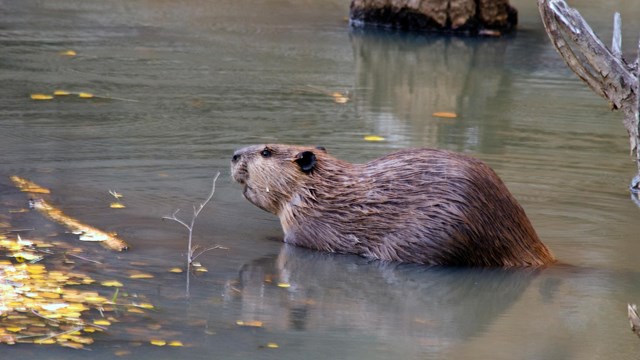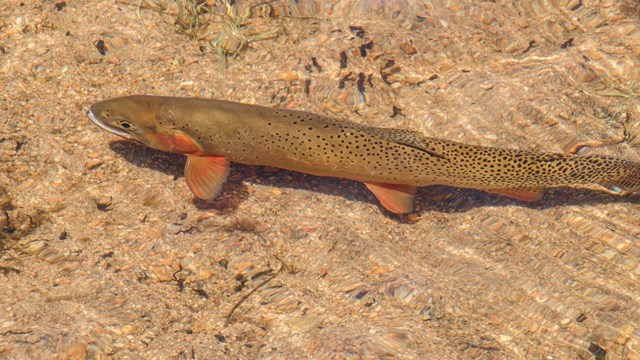
NPS Wetlands are critical ecosystems in Rocky Mountain National Park (RMNP). Wetland ecosystems account for just a fraction of the park, but they provide outsized benefits to the landscape and people. Wetlands provide important habitat for plants and animals, improve water quality, reduce wildfire impacts, and support a disproportionate amount of biodiversity per area. Click the links below to explore the plants and animals that depend on wetlands Wetlands Improve Water QualityWetland ecosystems can act like a giant filter, trapping sediment and improving the clarity of water. Slow flowing and ponded water allow particulates to settle out of suspension resulting in cleaner water. Riparian vegetation absorbs nitrogen and phosphorus – a process that removes excess, detrimental quantities of these nutrients from water sources, thus improving water quality. Wetlands Protect Against WildfiresWetlands can reduce the impact of drought, extreme precipitation events, and wildfire, making landscapes more resilient. By maintaining water on the landscape, wetlands help sustain and recharge groundwater systems, reduce the intensity of floods, and limit fire severity. After a wildfire, riparian beaver ponds capture significant amounts of sediment helping watersheds recover while protecting water quality. Types of Wetlands in RMNPThere are three major wetland types in the park - fens, wet meadows, and riparian wetlands. Each wetland type provides ecological benefits.
A History of Human InfluenceHumans have had both a direct and indirect influence on riparian wetlands in the Rocky Mountain Region. Indigenous peoples have occupied these landscapes since time immemorial. More recently, human influences included altering landscape hydrology, modifying vegetation communities, and wildlife management practices. These historical actions have had complex effects on wetland health and function. Beginning in the 1800s, settlers in this region began ditching and draining wetlands to support agricultural and tourism operations. In Moraine Park, humans drained wetlands and removed willow to facilitate cattle ranching, build swimming pools, and support a golf course. In the Kawuneeche Valley, several miles of historic ditches were dug, willow were removed, and exotic pasture grasses were planted to support cattle ranching operations. Wildlife management during the 1800s and early 1900s led to the removal of top predators like wolves and grizzly bears from the area which would later become RMNP, along with other native species like beavers and elk. Elk were reintroduced to the area prior to the establishment of the park and, without wolves and grizzly bears to help control their numbers, the elk population grew rapidly. This larger, less migratory elk population resulted in excessive winter browse on sensitive wetland vegetation. Initially, beaver populations decreased from trapping but remained low due to a lack of suitable habitat and forage caused by wetland degradation across the landscape.
NPS Wetland Ecosystem DeclineOver the last two centuries, some riparian wetland ecosystems in RMNP have transitioned away from willow-beaver wetlands characterized by beaver, high water tables, and water-loving tall willow communities. These ecosystems have now become moose-elk-grasslands characterized by narrow incised stream channels with lower water tables and less overbank flooding, an effectively non-existent beaver population, a lack of tall willow and of new willow growth due to elk and moose over browsing, and the increased presence of invasive species that favor warmer, drier conditions. Park staff and research partners have documented these declines in Horseshoe Park, Upper Beaver Meadows, and Moraine Park, as well as in the Kawuneeche Valley.Because of the ecological importance of riparian wetlands - and their documented decline - restoring these ecosystems has been a priority for Rocky Mountain National Park staff over the last several decades. Wetland Ecosystem ManagementRiparian wetlands in a small portion of the park have been actively managed since 2008 through the park’s Elk and Vegetation Management Plan (EVMP). This long-term plan allows park managers to protect important wetland plants (i.e., willow and aspen) from elk herbivory by fencing vegetation and managing elk populations. Park managers are also actively restoring wetland ecosystems by removing exotic species and planting riparian shrubs like willow, alder, and birch. On the west side of the park, restoration efforts in the Kawuneeche Valley began in 2023 and are ongoing. Park staff and research partners are also actively researching moose to better understand, in part, their population dynamics and the effects these large ungulates are having on wetland ecosystems.
Explore Wetlands
|
Last updated: December 3, 2025









